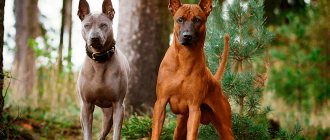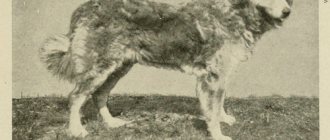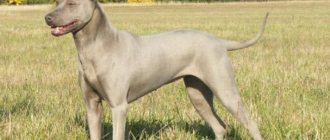History of the Thai Ridgeback breed
Thai Ridgeback
Four-legged inhabitants of eastern Thailand are among the original breeds, the development of which occurred without the intervention of breeders, according to the laws of natural selection. The history of Ridgebacks began about 3-4 thousand years ago - the first mentions of the breed date back to this period of time. They are represented by ancient drawings from Thailand and Cambodia, which depict similar dogs - presumably the ancestors of the Thai Ridgeback. They can be recognized by their erect ears and sickle-shaped tail. Here and there a characteristic ridge (comb of wool) can be seen on the backs of the animals.
The ancestors of the “Thais” also found their place in written sources. The Ayuth manuscript, dating from the first half of the 17th century, mentions dogs that have many similarities with modern Ridgebacks. There are no more precise “evidence” that would help trace the history of the breed, so the origin of these dogs is a closely guarded mystery. Most breeders adhere to the following version: Thai Ridgebacks are the result of a union of Aboriginal dogs and wild dingoes.
A share of uncertainty is inherent in the homeland of animals. Officially, island and mainland Thailand are considered to be the distribution range of Ridgebacks, but Indonesia is increasingly being named as a possible habitat for the first representatives of the breed.
In some ways, dogs are related to mongrels, if we interpret this word in the generally accepted sense. During the history of their existence, Thai Ridgebacks have not crossed with other breeds and appeared in the wild. The hot climate of the country forced the animals to get rid of their massive physique and thick coat. Each generation of Thai mongrels acquired more and more similarities with modern representatives of the breed.
The small distribution area of dogs became the reason for forced inbringing - mating of closely related individuals. Animals unsuitable for survival died, giving way to strong and hardy brothers. Then they were noticed by local residents who needed universal working dogs for hunting and property protection.
Thai Ridgeback puppy
The first attempts to domesticate wild animals began. Like all four-legged aborigines, the ancestors of Thai Ridgebacks were distinguished by their freedom-loving and independent disposition. For this reason, animals posed a danger even to their owners, not to mention strangers. However, attempts to domesticate wild dogs have not stopped. Ridgebacks were valued for their intelligence and agility. These qualities allowed the Thais to use animals as shepherds and draft power.
Ridgebacks were no less useful for hunting. Dogs accompanied the aborigines in hunting deer, tapirs, large wild boars and even birds. The lightning-fast reaction of animals made them indispensable companions for hunters. The courage with which dogs could rush at dangerous snakes and thereby save their owner from death was also useful.
The symbiosis of people and Thai Ridgebacks lasted until the 19th century. Along with technological progress, colonialists also came to the lands of the island of Phu Quoc (Phu Quoc), who took a liking to charming and unusual dogs. Ridgebacks caused a similar reaction among European merchants who traded with Thai aborigines. Word of a possibly new breed reached the leading dog handlers of the time. Having organized an expedition to Thailand, dog breeders were amazed: a previously unknown variety of dogs appeared before them!
It was impossible not to notice the characteristic feature - a ridge growing along the spine. There were no similar dogs among the known breeds, so dog experts decided to popularize the discovered animals.
Among the first countries to officially recognize Thai Ridgebacks were Thailand and Japan (1989 and 1990, respectively). Other states were in no hurry to jump to conclusions regarding the uniqueness of dogs. Only three years later, the international canine organization FCI registered the new breed and approved its standard. At that time, Ridgeback stud books numbered more than five thousand dogs.
Although two decades have passed since then, “Thais” still remain one of the least numerous breeds. Thai Ridgebacks are bred not only in their historical homeland, but also in America, as well as countries in Europe and Asia.
Thai Ridgeback light fawn color
Thai Ridgeback black color
History of the origin of the breed
Among the distinctive breeds that emerged through natural selection is the Thai Ridgeback, which originated in eastern Thailand. Despite the fact that breeders have never studied the breed, it meets all the laws of harmony.
For the first time, memories of her appeared 3-4 thousand years ago. The ancestors of animals are reflected in the drawings of Cambodia and Thailand. It is easy to recognize them as representatives of the modern breed by its characteristic features:
- ridge (comb made of wool);
- sickle-shaped tail;
- raised ears.
The origins of the Thai Ridgeback breed have different versions:
- Written references in the Ayuth manuscript of the 16th century, which describe dogs with such features.
- History has not preserved any other evidence of belonging to the ancestors, so this intriguing mystery will remain a mystery to the world.
- Breeders have their own version. They suggest that the Thai Ridgeback dog originated from a free union of wild dingoes with Aboriginal dogs.
The assumption about the homeland of the Thai Ridgeback remains ambiguous. The official version of Thailand is being questioned due to the emergence of suggestions that the habitat is Indonesia.
Representatives of the Thai Ridgeback breed have retained their originality to this day, without having mated in the wild. Under the influence of a hot climate, dogs lost their thick coat and massive build. The small range of the breed is the reason for inbreeding (mating of related individuals). The method of natural selection allowed the strongest individuals to survive.
The animals attracted the attention of local residents who needed dogs that would combine universal qualities (guards and workers):
- Animals with an independent, freedom-loving disposition began to be domesticated.
- This was associated with a danger to people's health and lives, but attempts continued.
- The Thai Ridgeback was valued for its agility and intelligence.
- Dogs were used as draft power, shepherds, and for hunting.
- People appreciated their lightning-fast reactions. With their help, large wild boars, deer, and even birds fell into the hands of hunters.
- Brave animals attacked the snakes, saving the life of the owner.
This is how the symbiosis of aborigines and dogs existed until the 19th century, until technological progress that came to the lands of Phu Quoc, where the Vietnamese Ridgeback lived, brought colonialists and European merchants. The news of a new exotic dog breed has reached the ears of dog handlers. Arriving in Thailand, the expedition of scientists was delighted not only by the discovery of a new breed, but also by its unusual beauty. The Thai Ridgeback breed has been popularized.
Interesting! Japan and Thailand were the first to recognize it in 1989. After 3 years, the breed was registered with the FCI (international organization of cynologists) along with the approval of the standard. The number of individuals in the stud books was over 5,000, however, the breed remains small. It is bred in its homeland, as well as in Asia, Europe and America.
Appearance of the Thai Ridgeback
The Thai Ridgeback is a large dog. The geographical isolation of the country and, as a consequence, the impossibility of inbreeding with other breeds led to a logical result. These animals managed to maintain their original appearance without drastic changes. The proportions of the Ridgeback's strong body are slightly incorrect: the height of the animal at the withers is less than the length of its body (ratio - 10:11). The muscles are developed.
The breed standard determines the height of females and males: 51-56 and 56-61 cm. The exact parameters for the weight of dogs are not specified, but it should be proportional to the height at the withers: about 23-34 kg for males and 16-25 kg for females.
Head and skull
Thai Ridgeback puppy in a blue sweater
The head shape of the Thai Ridgeback is classified as wolf-type. When examining the animal from the side, the sloping line of the forehead is noticeable. From time to time, small folds of skin appear on it when the Ridgeback is alert or interested. The skull is rounded, flattened in the area between the ears. Its length and front part are in a ratio of 3:2.
Muzzle
The wedge-shaped muzzle is slightly shorter than the top of the Ridgeback's head. The stop is expressed quite moderately, but at the same time is clearly visible from any angle. The smooth bridge of the nose tapers to a black or bluish shade (the latter is acceptable only for “Thais” of blue color). Expressive cheekbones contrast with flat cheeks. The dog's tight lips do not create a sensation of ruffles, since they adhere to the teeth and completely hide them.
Ears
The head of the Thai Ridgeback is “decorated” with medium-sized triangular ears. They are placed on the sides of the skull, slightly tilted forward. The tips are not rounded, the ears are open. Cupping is prohibited.
Eyes
The dog's large eyes are almond-shaped and set quite deep in relation to the muzzle. The eyelids are dry and fit tightly to the eyeballs; oval incision. Brown pigmentation of the iris is preferred (the richer the shade, the better). Blue animals have amber eyes.
Jaws and teeth
The Thai Ridgeback's strong and robust jaws form a scissor bite. The teeth sit tightly in the gum and form a complete set. The dog's tongue is notable for its black pigmentation or the presence of spots of the same color.
Neck
The strong neck of the “Thai” is set high and proud, characterized by a slight bend and lack of dewlap. Developed muscles can be easily felt through the skin of the animal.
Muzzle of a Thai Ridgeback
Frame
The body of the Thai Ridgeback is characterized by a moderately elongated format. The straight line of the back turns into a flat loin, and then into a rounded, sloping croup. The elongated ribs form a developed, oval-shaped chest, reaching the elbows. The abdomen and groin are tightened.
Tail
Thai Ridgeback blue color
The Ridgeback's relatively long tail is curved like a sickle and tapers from base to tip. It predominantly flies vertically upward.
Forelegs
The humerus and shoulder blades point backward. Straight forearms turn into pasterns, a slight slope of which is noticeable when examining the dog in profile. The Thai Ridgeback's paws are oval shaped and have crowded toes. The pads are harsh to the touch. The claws are strong, pigmented in dark or light shades (the second option is less preferable).
Hind limbs
Ridgeback hips are characterized by developed and strong muscles. The angles of the stifle and hock joints are pronounced, while the latter are located quite low. The parallel metatarsals are strictly straight, which is especially noticeable from the rear. The crowded toes form graceful oval-shaped paws. Both dark and light pigmentation of claws are acceptable. The pads are elastic and harsh.
Movement style
Thai Ridgebacks maintain a clear rhythm, stretching each step moderately, but not allowing the body to “wiggle.” The animal's front and hind limbs are not thrown out in any direction, providing a strong push. Movements are harmonious and free, with joints proportional to each other.
Coat
Thai Ridgeback in a muzzle
Ridgebacks are a short-haired dog breed. With their softness, the hairs resemble expensive velor. The undercoat is almost completely absent. Animal fur is divided into four categories.
- Super short velor (hair length – 0.1-0.3 cm). It looks the least presentable, since from a distance the dog appears bald. At the same time, short hair does not protect the Ridgeback from insect bites, which “decorate” the body with spots and blisters.
- Velvet (hair length – 0.5-0.8 cm). Delicate and pleasant to the touch. It does an excellent job of performing its protective function, unlike the previous type.
- Short (hair length - up to 1 cm). It is regarded as an intermediate type between velvet and standard.
- Standard (hair length – 1-2.5 cm). The coat protects not only from annoying insects, but also from unfavorable climatic conditions.
The key feature of the Thai Ridgeback is the clearly contoured ridge on the back. Among its common forms are:
- violin;
- guitar;
- arrow;
- skittle;
- saddle;
- igloo;
- sheet;
- feather.
The comb should not extend onto the dog's sides. Curls at the ends of the hairs are acceptable, and their symmetry is more than desirable. Ideally, the length of the ridge is ¾ of the length of the back. Minor deviations within 2-3 cm are not considered a rock defect.
Color
The standard recognizes solid colors of the following shades:
- light fawn;
- blue;
- red;
- black.
A white spot on the animal's chest is acceptable.
All colors of the Thai Ridgeback
Possible defects
Common defects in the Thai Ridgeback breed include:
- zigzag or broken ridge;
- straight and wedge-shaped bites;
- light pigmentation of the iris;
- rounded ear tips;
- atypical muzzle shape;
- full, jagged lips;
- abundant undercoat;
- round eye shape;
- short tail.
Disqualifying defects include:
- obvious deviations in appearance;
- fearful or aggressive behavior;
- undescended testicles into the scrotum;
- complete absence of ridge;
- white and brindle colors;
- long hair.
Description of the breed
The Thai Ridgeback is a medium-sized, athletically built dog with a ridge running along the spine. The body is muscular, with a slight imbalance: the front part of the body is slightly lowered.
Breed standard:
- Dimensions: height up to 61 cm, weight up to 32 kg.
- The head is flat with a low forehead. If the dog is alert, the skin on the forehead gathers in folds. The stop is clearly visible, but not so pronounced.
- The muzzle is wedge-shaped. The bridge of the nose is straight and long. The lobe is black. In individuals with a blue color, it has a bluish tint.
- Lips are “tight”, with rich pigmentation. The jaws are well developed, with a strong grip.
- The teeth are large, scissor bite. The eyes are almond-shaped, medium in size. The iris is dark brown. Dogs with a bluish coat have amber eye color.
- The ears are triangular, medium in size, tilted forward. Undocked, set straight. The neck is moderately long with well-developed muscles.
- The back is strong, level with a wide loin. Croup with a slight slope. The chest is set quite deep.
- The abdomen is dry and tight. The shoulders are set obliquely, tilted back. The limbs are straight, slightly shortened. Paws are oval.
- The tail is thick at the base, tapering gently towards the tip.
In general, the dog's appearance makes a strong impression. She does not look like the “standard” representatives of the species.
Colors
"Thais" are a short-haired breed. The hair structure is smooth. The ridge starts in the neck area. It is formed by pile growing in the opposite direction. The comb comes in different widths and lengths, but should not “slip” to one side. The “correct” ridge runs along the spine.
Coat types:
- standard (no more than 2 cm);
- Short (up to 1.2 cm);
- Velor (up to 0.5 cm);
- Super velor (up to 0.3 cm).
Color palette:
- red;
- black;
- blue;
- Isabelle color.
The most common color is red. Scientists believe that this is the color of the ancient MahTai. Red dogs have a wide, well-developed crest.
Black Ridgebacks must have black skin, nails and nose.
Blue color is quite rare. In the past, the color looked different: the gray background was diluted with black hairs. Currently, the “disadvantage” has become obsolete.
The Isabella color is a very light fawn. Dogs of this color are extremely rare.
Photo of a Thai Ridgeback
Personality of the Thai Ridgeback
Communication with a Thai Ridgeback is reminiscent of the famous film “The Taming of the Shrew.”
Only experienced dog breeders can find the key to a pet’s heart. Extravagant appearance is not the only difference between Thai Ridgebacks and other dogs. The character of these animals is characterized by resilience, bordering on stubbornness. It is impossible to rehabilitate a Ridgeback, and rare success in this matter will result in problems with the dog’s psyche. For this reason, representatives of the breed need an experienced and patient owner who is not afraid of difficulties in communicating with his pet. Remember: males tend to be more dominant and independent than females, so it is important to take this point into account when interacting with an animal.
However, you shouldn’t give up on Thai Ridgebacks just because of their independent nature! The owners of these dogs speak of them as the most loyal friends and companions. “Thais” cannot stand loneliness and prefer to bask in the rays of universal love and attention from their family. At the same time, it is important not to raise your voice at your pet if such strong intrusiveness annoys you. Representatives of the breed are distinguished by their fine mental organization, and rudeness from the owner will cause them irreparable offense.
Thai Ridgeback with owner
The developed intelligence of Thai Ridgebacks combined with their powers of observation gives an amazing result. Dogs carefully analyze what is happening, listen to people and distinguish between their intonations. In response to his nickname, the Ridgeback will demonstrate an extreme degree of interest and will not take his eyes off the speaker. At the same time, characteristic folds will appear on the animal’s forehead, which clearly indicate direct participation in the “dialogue.”
Representatives of the breed are quite contradictory in their desires: now they need an active walk, and five minutes later they are snoring comfortably on the bedding and dreaming of juicy meat bones. Thai Ridgebacks tend to adapt to their owner's lifestyle. “Coming out into the world” can wait until a certain moment: Ridgebacks will not jump on the door barking loudly and follow you with a leash in their teeth. However, the lack of fresh air and new experiences will negatively affect your pet’s balanced psyche.
Communication with strangers does not make the dog happy. Thai Ridgebacks are wary of strangers, do not allow themselves to be petted, and do not respond to affection with a friendly wagging of their tail. This distrust is the key to successfully fulfilling the role of a guard dog. However, Ridgebacks lack aggressiveness for ardent and selfless protection. The animal is more likely to utter a warning roar than to attack a person who has illegally invaded its domain. Loud barking and attacking are the last things you would expect from a Ridgeback. However, only a madman would encroach on the possessions of a serious and stately handsome man, reminiscent of a representative of fighting breeds, so the appearance of the “Thai” only plays into his hands.
And let your friends call the Ridgeback an unsociable “grump”: you know how affectionate and loving a pet can be! Representatives of the breed get along well not only with family members, but also with other pets. It’s not scary to leave even a cat in the company of a Thai Ridgeback: he would rather share the bedding with his meowing brother than give chase. Ridgebacks reserve the last activity for walks, where they will not miss a single yard cat, pigeon or sparrow. A loyal attitude towards other dogs is maintained only until open aggression on the part of the opponent.
Thai Ridgeback puppy playing with a rope
Ridgebacks dote on children and are ready to participate in their active games all day long. At the same time, dogs show complete leniency towards the carelessness of small family members and never respond to them with a menacing grin. However, frequent communication between a child and a “Thai” can make the latter extremely disobedient: the Ridgeback needs a firm hand and careful control, which cannot be expected from children. If possible, do not leave your pet alone with your child - this will avoid many incidents in the future.
Thai Ridgebacks are true four-legged athletes. These animals cannot imagine their life without running and jumping even from puppyhood. Adjust your daily routine so that your pet can burn off all his energy during a walk. Otherwise, the Ridgeback will demand a “continuation of the banquet” upon returning home. A ball, a frisbee, and even a stick raised from the ground are your best helpers.
The wild ancestors of the breed bequeathed hunting instincts to the dogs, which still make themselves felt and make walking without a leash almost impossible. Any living creature of smaller size is regarded by the Thai Ridgeback as prey, so it is important to control the pet at this moment. Please note: males run away more often than females, so you should not give them complete freedom of action.
Character
Ridgebacks are known for their free-spirited nature. They will never impose themselves and behave very tactfully. Some owners note that their habits are similar to those of cats. Ridgebacks are wary of strangers, but do not show aggression. Males tend to be independent, females are gentle and easy-going.
The Ridgeback is a socially active creature and is therefore not suitable for kennel keeping. He needs to be aware of events and constantly communicate with people.
MahTai are social creatures. They love to spend time with their owners, but will not accept affection from strangers. The Ridgeback gets along well with children and is willing to tolerate even rough treatment. This does not mean that you can allow a child to violate the dog’s personal space and treat it carelessly.
Ridgeback gets along well with cats and relatives. However, outside its “jurisdiction” it can give in to its instincts and start hunting for stray cats. Some MahTai tend to run away from their owner: such dogs can only be walked on a leash.
In general, this breed is not characterized by uncontrollability and aggression. If the owner decides to turn the “Thai” into a guard dog, he will have to spur on the guard’s instincts. There are naturally aggressive males: they make excellent watchdogs.
Thai Ridgebacks are known for their keen intelligence and ability to analyze situations. Therefore, they are often stubborn and disagree with the owner. Training needs to be built on a reward system: punishments will not have any effect.
Ridgeback will not tolerate physical violence! He will remember the insult for a long time and, if necessary, will take revenge.
Education and training
Training a Thai Ridgeback
Raising a Thai Ridgeback is not an easy task. Ideally, you should start training a dog at one and a half months of age, but often this is impossible: nurseries put puppies up for sale only when they reach three months. Adaptation of the baby to new conditions takes no more than a day: you should not give your pet any concessions from the first day of arrival in the house. Be persistent and diplomatic; Passivity and cruelty in dealing with a Ridgeback are unacceptable.
Having matured, the dog will not give up trying to test your patience “for strength”. Don't worry, your pet hasn't stopped feeling boundless love for you. The reason for this is the obstinate nature of the Thai Ridgeback. When communicating with an animal, you need to learn the following: the pet is always right, and only you can be considered the culprit of the current problem. It is quite difficult to come to terms with this idea, so do not deny yourself the opportunity to turn to a professional if the education of your Thai Ridgeback has gone in the wrong direction.
Ridgebacks are prone to begging near the table - and it’s not because they’re constantly hungry! In the eyes of a dog, the right to be the first to eat is the main sign of leadership. Let your pet know that you are not encroaching on his piece, but you are not going to hand over the reins either. The slightest compliance will result in the Ridgeback organizing daily duty in the kitchen, and you will have to isolate your pet during the family dinner.
Encouraging the Thai Ridgeback
Representatives of the breed are quick-witted and intelligent animals, so they are happy to learn new things, if, of course, they are in a good mood. Basic commands are indispensable, but equal attention should be paid to teaching discipline and self-control. By nature, Ridgebacks are not prone to impulsive behavior, but improper socialization can provoke cowardice or even aggression. Do not reward your dog if it shows intolerance towards anyone. Aggressive behavior must be stopped even if the Ridgeback rushes to your defense. Discreet praise is more than enough. An animal should not associate an animal grin with your boundless joy, otherwise a repeat incident is inevitable.
Praise, treats and motivation are the three pillars on which proper training of the Thai Ridgeback rests. Try to organize your dog's training in such a way that it resembles an exciting game. Otherwise, the dog will show indestructible stubbornness. The animal will easily understand the principle of simple commands and will resist studying them for a long time.
Representatives of the breed perform excellently in dog sports - in particular, freestyle and agility - so it is recommended to break up the monotonous training process with them.
Pros and cons of the breed
Dogs that meet the standards are considered purebred. Individual representatives of the breed may have certain deviations from the standard (defects), which will be the reason for refusal in exhibitions and competitions. Defects can hardly be called shortcomings, but they are the ones that influence the animal’s inferiority in various forms of dog competition for recognition of leadership among individuals of the breed. These include:
- the presence of a zigzag or torn ridge;
- rounded ears;
- atypical shape of the muzzle;
- the presence of jagged lips;
- abundance of undercoat;
- atypical tail shapes.
Dogs are also disqualified for a number of other reasons:
- obvious deviation from appearance;
- aggressive behavior or fearfulness;
- no ridge;
- brindle and white color;
- long coat.
Care and maintenance
The Thai Ridgeback is an ideal option for keeping in an apartment. It does not smell like “dog”, and the animal’s short hair does not cause unnecessary inconvenience even during shedding, which occurs once a year. “Velor” dogs lose much less hair than with a standard coat. Excessive shedding is a good reason to contact a veterinarian and have a scraping done to identify the presence of a subcutaneous mite.
Ridgeback coat care is quite simple and is limited to regular brushing twice a week. It is recommended to use a natural bristle brush or a rubber glove. They will not only remove dead hair, but also give your pet a pleasant massage that will improve blood circulation. During molting, you must repeat the procedure every day.
The absence of undercoat suggests the only possible option for keeping a Thai Ridgeback is in a room where there are no drafts. During the cold season, take care of warm clothes for your pet. Otherwise, colds will become a common occurrence, and the Ridgeback’s immunity will be significantly weakened.
Representatives of the breed cannot tolerate dampness and abundant moisture, so you should not deliberately give your pet a romantic walk in the rain. If bad weather finds you far from home, rest assured: the Thai Ridgeback, with its characteristic pedantry, will bypass all the puddles on its way. After such a walk, it is enough to wipe the animal’s paws: its cleanliness will not allow it to become completely dirty in the mud. Bathe your Ridgeback no more than once a month: this is more than enough. In addition, these dogs do not like water. For them, a hot day is not a reason to swim in the nearest body of water. On the contrary, the animal will go around it on the tenth road and try not to get its paws wet.
Important: when bathing your Thai Ridgeback, use only special pet shampoos with a mild formula. They will help avoid the aggressive effects of surfactants on your pet's fur.
A dog's open ears are a favorable environment for the proliferation of pathogens and the accumulation of dust. To avoid infections, clean your Thai Ridgeback's ears regularly using a cotton pad and a special hygiene product, which can be found in most pet stores. Alternatively, use weak boric acid.
Hello!
The animal's eyes deserve no less attention. Morning discharge in the corners is a common occurrence: thanks to them, accumulated dust particles are cleansed. These lumps can be easily removed with a damp, lint-free cloth. It is important not to wipe your eyes with the same side of the rag. For prevention purposes, it is necessary to use chamomile decoction once a week: this will prevent excessive “sourness.”
The Thai Ridgeback's teeth need to be brushed 3-4 times a week. Use special pastes for dogs: “human” hygiene products have a strong taste and smell, foam a lot and are therefore not suitable for the pet’s oral cavity.
Representatives of the breed are energetic and active animals that wear down their claws during long walks. Nevertheless, it is worth stocking up on a nail clipper for large breed dogs and shortening the Ridgeback’s claws once a month. It is recommended to first soak the paws in warm water: this will greatly facilitate and speed up the procedure.
Don't ignore your pet's paw pads. Inspect them for wounds or cracks. An antiseptic will cope with the first problem, and a thick baby cream or sunflower oil will cope with the second.
The diet of the Thai Ridgeback can be divided into two types: natural food and dry food. Under no circumstances should you combine them (for example, adding granules from a package to freshly cooked porridge): this will lead to problems with the dog’s digestive system.
The animal's diet must be balanced, with a complete content of essential macroelements and vitamins. Since Ridgebacks are not inclined to choose tidbits on their own, you will have to monitor the quality and freshness of the products. It is important to avoid:
- generously seasoned food;
- river fish in any form;
- boiled or raw fat;
- chocolate desserts;
- dairy products;
- fruits with seeds;
- raw meat and eggs;
- yeast dough;
- tubular bones;
- legumes;
- raw mushrooms;
- pork.
The gastrointestinal tract of Ridgebacks is highly sensitive, so you should not treat these dogs with new foods in large quantities. Introduce them gradually, while not forgetting to monitor your pet’s reaction.
The bowl should always be filled with fresh water. The ideal option is purified bottled water, but tap water, pre-infused for 6-8 hours, will also work.
Physical activity is a necessary condition for the proper maintenance of Thai Ridgebacks. Young dogs need two-hour walks; adult animals need half an hour in the morning and evening. Try to extend your walk whenever possible, and on weekends, even go out of town, where the Ridgeback can run around and explore new territory.
Health and diseases of Thai Ridgebacks
Natural selection, which played an important role in the thousand-year development of the breed, helped keep the dogs in good health and immune to traditional diseases. Most of the defects of Thai Ridgebacks are associated with their specific structure. Among the most common diseases are:
- problems with the digestive system;
- hip dysplasia;
- hypothermia and colds;
- dermoid sinus;
- dermatitis and eczema.
In addition, Thai Ridgebacks are prone to being overweight, which can lead to cardiovascular disease.
Diseases and life expectancy
The Thai Ridgeback, like all native species, is characterized by good health. He is free from most canine diseases, but may suffer from genetic disorders. These include dermoid sinus and hip dysplasia.
On average, MahTai live 12-16 years.
Comparison of breeds
Choosing a pet is a big decision, so it's always a good idea to consider your options.
The Thai Ridgeback and the Rhodesian Ridgeback have a number of fundamental differences. “Rhodesian” belongs to the group of hounds, “Thai” – primitive breeds. The name "Ridgeback" describes the presence of a crest, but does not make them related. In addition, ridge can also be found in other breeds.
The “Rhodesian” is distinguished by its drooping ears, large size and red color. There is a white spot on the chest.
No less significant are the differences in temperament. "Rhodesian" is a typical hunting dog. He follows his instincts and will hunt out of interest. This hound is also incredibly active and loves to bark. "Thais" have an intelligent character and hunt for food. Instead of barking, they make melodic, mournful sounds.
The Thai Ridgeback and Basenji are among the oldest breeds, but that's where the similarities end. The Basenji is close to the pharaoh's hound and looks like it came straight out of an Egyptian fresco. This is a small, up to 43 cm dog with a red and white, tri-color or brindle color. Instead of barking, it makes peculiar sounds and is known as the “silent dog.”
Basenjis are very active and require long walks. They need space to run around, so it is recommended to keep them in a house with a spacious yard. This breed can be willful and stubborn and is suitable exclusively for active owners.
Each breed has its own strengths and weaknesses, so it should be selected based on character. If the owner realizes that the animal is not suitable for him, this can become a huge problem.
How to choose a puppy
All dogs require attention and love from their owner, and the Thai Ridgeback is a good example. This bundle of indomitable energy needs proper education, training and daily walks. Are you ready to devote every free minute to your pet? Now all that’s left to do is choose the right puppy!
The first step towards acquiring a four-legged friend is selecting a specialized nursery. Look for organizations that provide the necessary information about the puppy's parents. If they don’t have a single title at their disposal, think about it: most likely, the reason lies in invisible vices that will certainly affect the kids.
A professional breeder provides a veterinary passport, a leaflet for the future Ridgeback owner and FCI documents. The puppy must be branded, vaccinated and wormed in a timely manner. When getting to know your litter, pay attention to the most active and moderately curious baby - he is destined to become your companion! And don't be put off by the Shar Pei's skin folds: they will disappear as the dog gets older.
Photos of Thai Ridgeback puppies
How much does a Thai Ridgeback cost?
Thai Ridgebacks are rare and therefore very expensive dogs. Breeders mainly visit European countries to breed Ridgebacks, so the cost of the animals justifies the additional costs. The price of puppies from the nursery starts from 100 thousand rubles and increases to cosmic sums of a million! Of course, you can save money by purchasing a “purebred” dog at a poultry market or secondhand, but it is not a fact that you will get a healthy and balanced pet. If this price is disproportionate to your budget, pay attention to less expensive breeds - in any case, you will not be left without your best friend!











